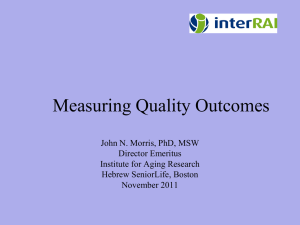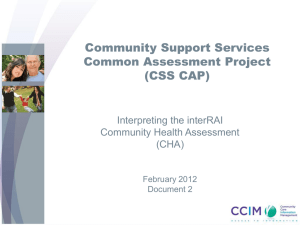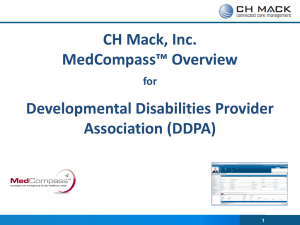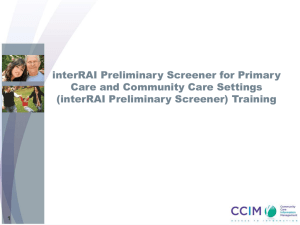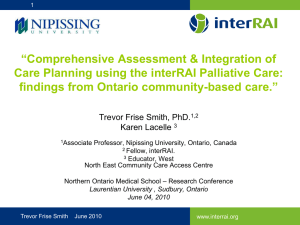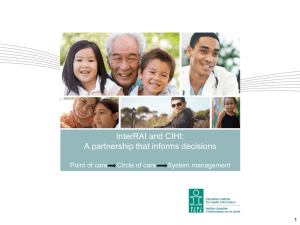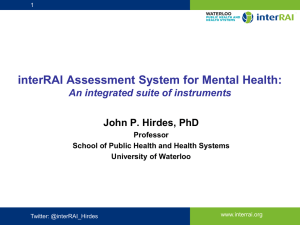Standardisation of Aged Care Assessment
advertisement
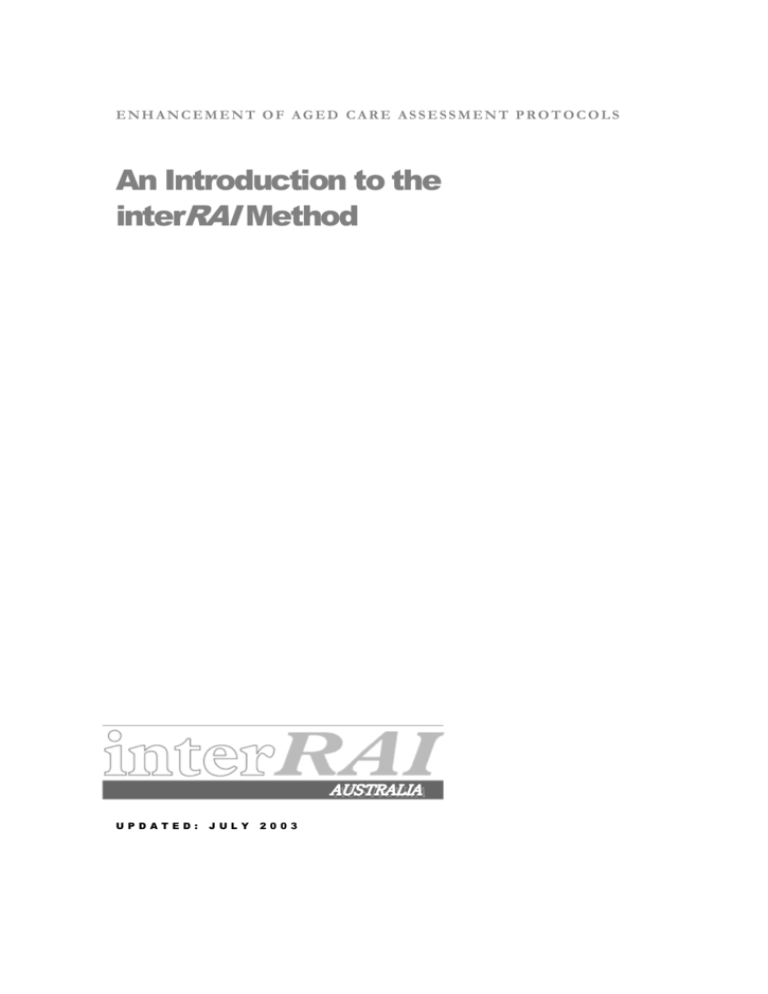
ENHANCEMENT OF AGED CARE ASSESSMENT PROTOCOLS An Introduction to the interRAI Method UPDATED: JULY 2003 SECTI ON 1: The interRAI protocols & instruments This paper outlines a method for enhancing clinical care that utilises standardised clinical protocols and data collection in aged care and associated services. The approach has been developed by interRAI, an international collaborative of scientists and clinicians that aspires to improve the quality and efficiency of care delivery in health care services. InterRAI was established in 1992. Currently, almost 50 researchers and clinicians from over 20 nations constitute interRAI. Australian involvement commenced in 2001, and New Zealand in 2002. A series of assessment methodologies have been developed by InterRAI in a wide variety of clinical practice domains from acute care to long-term residential care. Why standardise? Assessment of older people is more than just assessment. It is an important intervention in its own right that influences the health and social outcomes for sick, frail and disabled older people. The process needs to be designed and implemented carefully to optimise these outcomes. ASSESSMENT IS EVERYWHERE… The process of assessment of older patients within health care services is an increasingly pervasive process. Assessments are conducted a wide variety of settings and contexts. Domains of the assessment tend to be repetitive. For example, cognitive function and mood, continence, ability to perform activities of daily living and the social support network are frequently re-appraised with varying degrees of detail across services. LACK OF STANDARDISED FORMATS LEADS TO REPETITION AND INEFFICIENCY… Assessments range from extensive multi-disciplinary assessments in Geriatric Evaluation and Management wards to simple screening tools in emergency departments. This information is repeatedly collected in a variety of formats as individuals proceed through various aspects of the service network. There is no capacity to transfer such information with the person, except when the medical record accompanies him. Even then the information tends to be recollected using a different protocol. ELECTRONIC REFERRAL AND ASSESSMENT REQUIRES CONSISTENCY… An essential pre-requisite for transfer of person level data from one service environment to another is item consistency. Each element of a data set needs to be framed in an identical format, so it can automatically become a component of an assessment protocol for the accepting service. The item can be updated if necessary in accordance with changes in the state of the subject. The item itself should only be modified if the circumstances demand it. CONSISTENT DATA COLLECTION HAS OTHER BENEFITS… If all services agree on the use of a consistent suite of tools, there are additional extensive benefits: I N T R O D U C T I O N T O T H E I N T E R R A I M E T H O D Information can be transferred readily between services All staff can be trained with the same set of tools, enabling improved data integrity, and capacity to transfer staff from one service to another more readily Patient profiles can be compared between services within Health Services; between like services between Health Services; and if the right tools are used, with services outside of Australia A MINIMUM HIGH STANDARD CAN BE ASSURED The use of a standardised approach to assessment and care planning, supported by appropriate training and documentation, offers the ability to ensure that assessment and care planning reaches at least a minimum standard across services and among individual health professionals. Practitioners using a standard method can then conduct additional assessment, when required, knowing that the core assessment and care planning processes are assured. Moreover, some aspects of assessment and care planning can be automated, using electronic databases in a computerised environment. What do we currently use? Most aged care services have developed assessment protocols through a process of internal expert-devised questions. For example, “Is the patient incontinent of urine – never / occasionally / frequently”. These questions are supplemented, in some cases, with widely used specific screening or assessment tools that focus on a particular domain – the Abbreviated Mental Test for cognition, the Barthel Index for ADLs. As best can be ascertained, these protocols (other than the special purpose instruments) have not been subject to any vigorous evaluation (eg inter-rater reliability), nor have they been methodically reviewed for many years. There is no training program to ensure that staff collects them with consistent interpretation. There is no documentation to support the process. Definitions are not documented. What tools should be used? A successful assessment protocol might have the following characteristics: It embraces all the domains of assessment that are usually required. It is in modular format so that it can be customised to subgroups and a variety of circumstances. It is well documented including definitions, method of administration and interpretation. It has been subjected to testing for reliability and validity. For example, different assessors should produce consistent findings (inter-rater reliability). It can be completed in the same time frame as current assessment protocols. It is integrated with care planning processes. It is in wide use enabling comparison with other services. It contains scales that provide a view of severity (eg cognitive performance, ADL function) 3 It contains data items that can be used to develop resource allocation tools. It has capacity to link with quality indicators. It relates to assessment protocols in other service domains to which the subject is likely to be transferred, enabling transfer of information between services. The interRAI suite of instruments has been developed with these criteria in mind. The suite meets most of these criteria to a significant degree. Section 2 describes the InterRAI protocols. I N T R O D U C T I O N SECTI ON T O T H E I N T E R R A I M E T H O D 2: The InterRAI Suite of Assessment Protocols This section provides an introduction to the InterRAI suite of instruments. What are the interRAI protocols? The interRAI suite of instruments has been developed over the past 15 years by an international collaborative group of clinicians and scientists, who are committed to the development of datasets for health care delivery with an emphasis on chronic illness and its management. InterRAI protocols are “second generation instruments”, in that they approach assessment from a “whole of person” perspective, integrating elements into a comprehensive tool. By comparison, most other instruments only deal with one aspect of a person’s problem, such as activities of daily living, cognitive function or mood. Others are compilations of such instruments. The original tool, the Resident Assessment Instrument – Minimum Data Set for residential care – is now in widespread use in nursing homes in many countries. Its use is mandatory for nursing homes in the USA and several other countries. The Home Care version is now mandated in several Canadian provinces and is widely utilised in others. Versions of the tool have been widely used to perform international comparative studies. In excess of 350 publications involve the instrument. Screening versions of some instruments are available. The protocols are grounded in best available evidence, by international expert panels. Each protocol is rigorously tested to ensure high levels of consistency among assessors. Protocols are regularly revised and updated, in a similar manner to computer software. The residential care protocol is the most mature instrument and is now in Version 3.0. A degree of customisation is permitted in each country, but interRAI aims to preserve consistency of data sets across countries and cultures. Each protocol consists of a “mimimum data set” (MDS) and a series of assessment protocols that are “triggered” by single or combinations of responses in the data set. The MDS is minimum in the sense that the data set is considered minimum to provide a competent, holistic assessment of an individual with complex care requirements. The content and scope of each MDS is driven by clinical considerations, not primarily for reporting purposes to a funding agency, which is typically the case for other minimum data sets in Australia. The assessment protocols, variously described as CAPs (client assessment protocols in home care), RAPs (resident assessment protocols in residential care), etc, provide guidance to clinicians on further assessment or management. Each instrument is supported by a training and reference manual. The level of documentation is extensive. For example the Home Care version is supported by a 320 page manual, approximately half of which provides instruction on assessment procedure, and half on client assessment protocols (CAPs). Assessments are undertaken by health professionals who are specifically trained in the use of the relevant protocol. This ensures a consistent, high standard of care and data integrity. 5 These tools are developed in an “evidence-based” spirit, and are rigorously field tested before implementation. Where-ever possible, components of the tool are shared across the suite of instruments. RAI Assessment Protocol Triggers Assessment protocols (RAPs, CAPs...) Clinical database Quality indicators Benchmarking Resource allocation (Casemix) Care plan Follow-up assessments Figure 1: Overview of the RAI approach The assessment instruments are highly sophisticated in their scope and development, yet able to be administered by a trained health profession with a modest amount of specific training in its use. The instruments are suited to use by services that require in depth holistic assessment of frail older people. For example, the interRAI – HC would be appropriate for use by an Aged Care Assessment Team, and the interRAI – PAC (post-acute care) by an inpatient geriatric unit. The protocols are designed to be administered in 60-75 minutes. The tools also fulfil subsidiary functions that include benchmarking, quality monitoring and resource allocation. The interRAI -LTC for nursing homes enables classification of residents into Resource Utilisation Groups (RUGs III) that in many countries is used as the basis of funding. Quality indicators have been derived from the dataset that are in formal use in some countries. For example, the interRAI –LTC enables monitoring the rates of restraint use and pressure ulcers in residential care. A comprehensive set of quality indicators, derived from the interRAI, will soon be reported in the public domain for all nursing homes in the USA. The range of instruments Tools are in varying stages of development, depending on the level of investment that has been secured. The tools are: Residential / long term care (interRAI -LTC) Home care (interRAI -HC) includes a “screener” Acute care (interRAI -AC) Post-acute (subacute) care (interRAI -PAC) Palliative care (interRAI -PC) Mental health (all age groups) (interRAI -MH) In development: I N T R O D U C T I O N T O T H E I N T E R R A I M E T H O D Community mental health (interRAI -CMN) Assisted living (for low intensity residential care) (interRAI -AL) Disability (for people with acquired disability) (interRAI -PWD) A process of review of all instruments is currently occurring to ensure that they are fully “harmonised”. When concluded, all instruments will contain core items, in standardised format, that will facilitate information transfer across care domains. This process will be concluded, following extensive field testing of new instruments, in 2004. Thus, new versions of all instruments are anticipated for release in 2004. Scales within interRAI protocols A variety of scales have been developed using items within interRAI protocols. These have been validated, and in most cases validated against conventional scales. They include: Cognitive performance scale Depression rating scale IADL scales (IADL difficulty scale, IADL involvement scale, IADL summary scale) ADL scales (ADL short form, ADL self-performance hierarchy scale, ADL long form) Changes in Health, End-stage disease and Signs and Symptoms (CHESS) Pain scale These scales provide an additional dimension to interpretation of an interRAI assessment. They assist with identification of syndromes (eg the cognitive performance scale) and with assessment of the extent of a problem (eg the ADL scales). 7 SECTI ON 3 interRAI protocols in Australia Unlike numerous other countries, where use is widespread or even mandated, Australia has little exposure to the interRAI approach. Has anyone in Australia used it? The interRAI-HC was used in the Phase 1 coordinated care trial based at Bundoora Extended Care Centre. It was applied to over 500 clients. Some 40 field workers were trained in its use. The tool is now configured in electronic form and data can be entered in the field on a laptop computer. The assessment responses electronically “trigger” CAPs and suggest possible interventions. Data can be transferred between staff of the trial and can be accessed by GPs involved in the client’s care. The Department of Health and Aged Care is recommending its use in Phase 2 CCTs. The acute care version (interRAI-AC) is currently being trialled in a randomised trial at the Mater Hospital in Brisbane to establish its efficacy in improving the outcomes for frail older people treated in acute medical wards. Why consider its use? Given the growing plethora of demands on services to adopt standardised protocols and report “minimum data sets”, it seems a formidable task to adopt a new methodology. There is a risk of duplication of effort. At start up, additional effort or resources may be required. However… Few if any of the protocols in current use have been properly developed and validated. Within individual services, most protocols are home grown, or modified from another service. While some contain elements that relate to a validated instrument (such as the Barthel index), the majority of the protocol consists of idiosyncratic data items or open format text. The only data systems in widespread use have been produced for reporting purposes to funding agencies to assist planning or to generate funding through casemix payment systems. These are valuable and important processes, but they are not designed to directly assist in client or patient care. Using the interRAI approach can: Improve the reliability and quality of assessment and care planning Enable participation in benchmarking and research with other organisations Provide a starting point for information exchange with local service organisations As interRAI use becomes widespread, translation of date items to mandatory reporting formats for local circumstances will become feasible and effective. interRAI Australia The coordinating centre for interRAI activities is based at the University of Queensland. This centre will provide the conduit to InterRAI and assist interested organisations to access tools and training resources. I N T R O D U C T I O N T O T H E I N T E R R A I M E T H O D Who can use interRAI protocols? interRAI protocols are copyright and permission to use these tools must be obtained from interRAI. For research and development purposes, approval may be obtained from the interRAI Australia Coordinating Centre. For ongoing use, a formal agreement must be made with interRAI central office. This can be facilitated through the Australian office. These arrangements have been established for several reasons: To prevent modification of the instruments without interRAI approval. To enable interRAI to monitor their use. To underpin arrangements for data pooling to support international studies and ongoing development of the instruments. It is important to appreciate that there is no charge for use of the instruments, even though formal agreements must be sought. interRAI is a not-for-profit organisation whose income streams are largely confined to royalties from the sale of manuals, licensing to software developers and vendors, from research and development grants and voluntary support from the members (ie interRAI Fellows). Total international income is extremely modest. All income is used to support development and maintenance of the instruments. The international website address is http://www.interrai.org/. A completely revised site will be opened late in 2003. The Australian interRAI Fellow is Professor Len Gray. Contact details for the Coordinating Centre are: c/- University Department of Medicine Princess Alexandra Hospital Ipswich Rd., Woolloongabba Queensland 4102 Tel: 07-32406428 Fax: 07-32405399 Email: lgray@soms.uq.edu.au 9 APPENDI X 1 Citations Selected examples of published work involving InterRAI instruments are listed: Carpenter, G. I., G. F. Teare, et al. (2001). "A new assessment for elders admitted to acute care: reliability of the MDS-AC." Aging Milano, Italy 13(4): 316-30. Fries, B. E., C. Hawes, et al. (1997). "Effect of the National Resident Assessment Instrument on selected health conditions and problems." J Am Geriatr Soc 45(8): 994-1001. Fries, B. E., M. Schroll, et al. (1997). "Approaching cross-national comparisons of nursing home residents." Age Ageing 26 Suppl 2: 13-8. Fries, B. E., L. R. Shugarman, et al. (2002). "A screening system for Michigan's home- and community-based long-term care programs." Gerontologist 42(4): 462-74. Hartmaier, S. L., P. D. Sloane, et al. (1995). "Validation of the Minimum Data Set Cognitive Performance Scale: agreement with the Mini-Mental State Examination." J Gerontol A Biol Sci Med Sci 50(2): M128-33. Hirdes, J. P., B. E. Fries, et al. (1999). "Integrated health information systems based on the RAI/MDS series of instruments." Healthc Manage Forum 12(4): 30-40. Hirdes, J. P., M. Marhaba, et al. (2000). "Development of the Resident Assessment Instrument--Mental Health (RAI- MH)." Hosp Q 4(2): 44-51. Hirdes, J. P., D. Zimmerman, et al. (1998). "Use of the MDS Quality Indicators to Assess Quality of Care in Institutional Settings." Canadian Journal of Quality in Health Care 14(2): 5-12. Mor, V., O. Intrator, et al. (1997). "Changes in hospitalization associated with introducing the Resident Assessment Instrument." J Am Geriatr Soc 45(8): 1002-10. Morris, J., R. Bernabei, et al. (1997). RAI-Home Care (RAI-HC) Assessment Manual. Primer on use of Minimum Data Set-Home Care (MDS-HC) Version 10a and the Client Assessment Protocols (CAPs). Morris, J. N., B. E. Fries, et al. (1994). "MDS Cognitive Performance Scale." J Gerontol 49(4): M174-82. Morris, J. N., B. E. Fries, et al. (1999). "Scaling ADLs within the MDS." J Gerontol A Biol Sci Med Sci 54(11): M546-53. Morris, J. N., B. E. Fries, et al. (1997). "Comprehensive clinical assessment in community setting: applicability of the MDS-HC." Journal of the American Geriatrics Society 45(8): 1017-24. Phillips, C. D., J. N. Morris, et al. (1997). "Association of the Resident Assessment Instrument (RAI) with changes in function, cognition, and psychosocial status." J Am Geriatr Soc 45(8): 986-93. (Morris, Fries et al. 1994) (Morris, Fries et al. 1999) (Hartmaier, Sloane et al. 1995) (Mor, Intrator et al. 1997) (Morris, Bernabei et al. 1997) (Morris, Fries et al. 1997) (Fries, Hawes et al. 1997) (Fries, Schroll et al. 1997) (Fries, Shugarman et al. 2002) (Carpenter, Teare et al. 2001) (Hirdes, Fries et al. 1999) (Hirdes, Marhaba et al. 2000) (Hirdes, Zimmerman et al. 1998) (Phillips, Morris et al. 1997)

